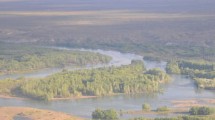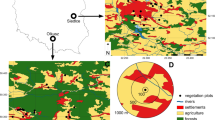Abstract
Willows invade many riparian environments around the world. Understanding the environmental factors that affect the establishment of non-native invasive plants, as well as characterizing population structure and stages of invasion, are crucial steps to define priority areas for monitoring and management. In this study, we characterized the population structure of the hybrid invasive tree Salix × rubens, determined the stage of the invasion process, and identified relevant factors for the establishment of regenerating plants in a subtropical riparian system in southern Brazil. We assessed population structure by measuring stem perimeter and height of plants sampled along river banks and riverbeds along several rivers, and measured environmental variables that may explain abundance patterns of regenerants. We showed that the majority of regenerants developed in riverbeds. The species seems to be transitioning between the establishment and dispersal phases of the invasion process. The abundance of regenerants was affected mainly by the abundance of nearby S. × rubens adults. Abundance of regenerants was negatively influenced by canopy openness, an unexpected result since S. × rubens is considered light-demanding. Our study provides insights for management strategies of S. × rubens, which must focus on searching sites along rivers where adult trees are present.
Resumen
Los sauces invaden numerosos ambientes riparios alrededor del mundo. Comprender los factores ambientales que afectan el establecimiento de plantas exóticas invasoras, así como caracterizar la estructura poblacional y las etapas del proceso de invasión, son pasos cruciales para definir áreas prioritarias para su monitoreo y manejo. En este estudio caracterizamos la estructura poblacional del árbol híbrido invasor Salix × rubens, determinamos la etapa del proceso de invasión e identificamos factores relevantes para el establecimiento de renovales en un sistema ripario subtropical en el sur de Brasil. Evaluamos la estructura poblacional midiendo el perímetro del tallo y la altura de los individuos localizados en las riberas y cauces de varios ríos, y medimos las variables ambientales que pueden explicar los patrones de abundancia en la regeneración. Demostramos que la mayoría de los renovales estaban en los cauces de ríos. La especie estudiada parece encontrarse en la transición entre las fases de establecimiento y dispersión en el proceso de invasión. La abundancia de los renovales fue afectada principalmente por la abundancia de los adultos cercanos de S. × rubens. La abundancia de los renovales fue afectada negativamente por la abertura del dosel, un resultado inesperado debido a que S. × rubens es luz-dependiente. Nuestro estudio aporta perspectivas para estrategias de manejo de S. × rubens, las cuales deben centrarse en la búsqueda de sitios cercanos a ríos donde árboles adultos de S. × rubens están presentes.



Similar content being viewed by others
Data availability
The datasets generated during the current study are available from the corresponding author on reasonable request.
References
Adair R, Sagliocco J-L, Bruzzese E (2006) Strategies for the biological control of invasive willows (Salix spp.) in Australia. Aust J Entomol 45:259–267. https://doi.org/10.1111/j.1440-6055.2006.00548.x
Asaeda T, Gomes PIA, Sakamoto K, Rashid MdH (2011) Tree colonization trends on a sediment bar after a major flood: re-generation of trees after a major flood. River Res Applic 27:976–984. https://doi.org/10.1002/rra.1372
Barton K (2009) MuMIn: Multi-Model Inference
Beismann H, Wilhelmi H, Baillères H et al (2000) Brittleness of twig bases in the genus Salix: fracture mechanics and ecological relevance. J Exp Bot 51:617–633. https://doi.org/10.1093/jexbot/51.344.617
Blackburn TM, Pyšek P, Bacher S et al (2011) A proposed unified framework for biological invasions. Trends Ecol Evol 26:333–339. https://doi.org/10.1016/j.tree.2011.03.023
Breheny P, Burchett W (2017) Visualization of regression models using visreg. R J 9:56. https://doi.org/10.32614/RJ-2017-046
Budde KB, Gallo L, Marchelli P et al (2011) Wide spread invasion without sexual reproduction? A case study on European willows in Patagonia, Argentina. Biol Invasions 13:45–54. https://doi.org/10.1007/s10530-010-9785-9
Ceolin GB, Giehl ELH (2017) A little bit everyday: range size determinants in Arachis (Fabaceae), a dispersal-limited group. J Biogeogr 44:2798–2807. https://doi.org/10.1111/jbi.13082
Cremer KW (2003) Introduced willows can become invasive pests in Australia. Biodiversity 4:17–24. https://doi.org/10.1080/14888386.2003.9712705
de Wagner MA, de Moço MC, Sawczuk AT, Soffiatti P (2009) Wood anatomy of Salix × rubens Schrank used for basketry in Brazil. Hoehnea 36:83–87
Francis RA, Gurnell AM, Petts GE, Edwards PJ (2006) Riparian tree establishment on gravel bars: interactions between plant growth strategy and the physical environment. In: Sambrook Smith GH, Best JL, Bristow CS, Petts GE (eds) Braided Rivers. Blackwell Publishing Ltd., Oxford, pp 361–380
Gallardo B, Clavero M, Sánchez MI, Vilà M (2016) Global ecological impacts of invasive species in aquatic ecosystems. Glob Change Biol 22:151–163. https://doi.org/10.1111/gcb.13004
Gehrig SL (2010) The role of hydrology in determining the distribution patterns of invasive willows (Salix) and dominant native trees in the Lower River Murray (South Australia). Ph.D., University of Adelaide, School of Earth and Environmental Sciences
Greenwood H, O’Dowd DJ, Lake PS (2004) Willow (Salix × rubens) invasion of the riparian zone in south-eastern Australia: reduced abundance and altered composition of terrestrial arthropods: Impacts of riparian zone invasion on arthropods. Divers Distrib 10:485–492. https://doi.org/10.1111/j.1366-9516.2004.00104.x
Gurnell A (1997) The Hydrological and geomorphological significance of forested floodplains. Glob Ecol Biogeogr Lett 6:219. https://doi.org/10.2307/2997735
Hartig F (2016) DHARMa: residual diagnostics for hierarchical (multi-level/mixed) regression models
Holland-Clift S, O’Dowd DJ, Mac Nally R (2011) Impacts of an invasive willow (Salix × rubens) on riparian bird assemblages in south-eastern Australia: willow invasion and bird assemblages. Austral Ecol 36:511–520. https://doi.org/10.1111/j.1442-9993.2010.02178.x
Holland-Clift S, Davies SJ (2007) Willows management guide: current management and control options for willows (Salix sp.) in Australia. Victorian Department of Primary Industries, Geelong
Hood WG, Naiman RJ (2000) Vulnerability of riparian zones to invasion by exotic vascular plants. Plant Ecol 148:105–114. https://doi.org/10.1023/A:1009800327334
Hupp CR, Osterkamp WR (1996) Riparian vegetation and fluvial geomorphic processes. Geomorphology 14:277–295. https://doi.org/10.1016/0169-555X(95)00042-4
Karrenberg S, Edwards PJ, Kollmann J (2002) The life history of Salicaceae living in the active zone of floodplains: Salicaceae on flood plains. Freshw Biol 47:733–748. https://doi.org/10.1046/j.1365-2427.2002.00894.x
Kottek M, Grieser J, Beck C, et al (2006) World Map of the Köppen-Geiger climate classification updated. metz 15:259–263. https://doi.org/10.1127/0941-2948/2006/0130
Liotta J (2001) Rasgos biológicos de Salix humboldtiana Willd. y régimen de pulsos de inundación. Interciencia 26:397–403
Magnusson A, Skaug H, Nielsen A, et al (2020) Generalized linear mixed models using template model builder. Package glmmTMB
Marquete R, Torres RB, Medeiros ES (2015) Salicaceae in Lista de Espécies da Flora do Brasil
McAlpine KG, Jesson LK (2008) Linking seed dispersal, germination and seedling recruitment in the invasive species Berberis darwinii (Darwin’s barberry). Plant Ecol 197:119–129. https://doi.org/10.1007/s11258-007-9365-y
Moggridge HL, Gurnell AM (2009) Controls on the sexual and asexual regeneration of Salicaceae along a highly dynamic, braided river system. Aquat Sci 71:305–317. https://doi.org/10.1007/s00027-009-9193-3
Mosner E, Schneider S, Lehmann B, Leyer I (2011) Hydrological prerequisites for optimum habitats of riparian Salix communities—identifying suitable reforestation sites: optimum habitats of riparian Salix communities. Appl Veg Sci 14:367–377. https://doi.org/10.1111/j.1654-109X.2011.01121.x
Naiman RJ, Décamps H (1997) The ecology of interfaces: riparian zones. Annu Rev Ecol Syst 28:621–658. https://doi.org/10.1146/annurev.ecolsys.28.1.621
Newsholme C (1992) Willows, the Genus Salix. Timber Press Inc
Oliveira ACD, Piedade MTF (2002) Implicações ecológicas da fenologia reprodutiva de Salix martiana Leyb. (Salicaceae) em áreas de várzea da Amazônia Central1. Acta Amaz 32:377–377. https://doi.org/10.1590/1809-43922002323385
Osterkamp WR, Hupp CR (2010) Fluvial processes and vegetation—Glimpses of the past, the present, and perhaps the future. Geomorphology 116:274–285. https://doi.org/10.1016/j.geomorph.2009.11.018
R Core Team (2020) R: A language and environment for statistical computing
Read MG, LeoNA B (1999) Comparisons of benthic communities adjacent to riparian native eucalypt and introduced willow vegetation: riparian vegetation and invertebrates. Freshw Biol 42:359–374. https://doi.org/10.1046/j.1365-2427.1999.444474.x
Rejmánek M, Richardson DM, Pyšek P (2013) Plant invasions and invasibility of plant communities. In: Van Der Maarel E, Franklin J (eds) Vegetation Ecology. Wiley, Oxford, pp 387–424
Renöfält BM, Jansson R, Nilsson C (2005) Spatial patterns of plant invasiveness in a riparian corridor. Landscape Ecol 20:165–176. https://doi.org/10.1007/s10980-004-2262-z
Richardson DM, Pysek P, Rejmanek M et al (2000) Naturalization and invasion of alien plants: concepts and definitions. Divers Distrib 6:93–107. https://doi.org/10.1046/j.1472-4642.2000.00083.x
Richardson DM, Holmes PM, Esler KJ et al (2007) Riparian vegetation: degradation, alien plant invasions, and restoration prospects: riparian vegetation: degraded, invaded, transformed. Divers Distrib 13:126–139. https://doi.org/10.1111/j.1366-9516.2006.00314.x
Riis T (2008) Dispersal and colonisation of plants in lowland streams: success rates and bottlenecks. Hydrobiologia 596:341–351. https://doi.org/10.1007/s10750-007-9107-0
Shafroth PB, Scott ML, Friedman JM, Laven RD (1994) Establishment, sex structure and breeding system of an exotic riparian willow. Salix X Rubens Am Midland Naturalist 132:159. https://doi.org/10.2307/2426210
Sher AA, Marshall DL, Taylor JP (2002) Establishment patterns of native Populus and Salix in the presence of invasive Tamarix. Ecol Appl 12:760–772. https://doi.org/10.1890/1051-0761(2002)012[0760:EPONPA]2.0.CO;2
Speziale KL, Lambertucci SA, Carrete M, Tella JL (2012) Dealing with non-native species: what makes the difference in South America? Biol Invasions 14:1609–1621. https://doi.org/10.1007/s10530-011-0162-0
Sühs RB, de Dechoum MS, Ziller SR (2020a) Invasion by a non-native willow (Salix × rubens) in Brazilian subtropical highlands. Perspect Ecol Conserv 18:203–209. https://doi.org/10.1016/j.pecon.2020.09.001
Sühs RB, Giehl ELH, Peroni N (2020b) Preventing traditional management can cause grassland loss within 30 years in southern Brazil. Sci Rep 10:783. https://doi.org/10.1038/s41598-020-57564-z
Thomas LK, Leyer I (2014) Age structure, growth performance and composition of native and invasive Salicaceae in Patagonia. Plant Ecol 215:1047–1056. https://doi.org/10.1007/s11258-014-0362-7
Thomas LK, Tölle L, Ziegenhagen B, Leyer I (2012) Are vegetative reproduction capacities the cause of widespread invasion of Eurasian salicaceae in patagonian river landscapes? PLoS ONE 7:e50652. https://doi.org/10.1371/journal.pone.0050652
Thomas LK, Mosner E, Leyer I (2015) River dynamics and invasion: distribution patterns of native and invasive woody vegetation at the Río Negro, Argentina. Riparian Ecol Conser 2:45–57. https://doi.org/10.1515/remc-2015-0001
Tickner DP, Angold PG, Gurnell AM, Mountford JO (2001) Riparian plant invasions: hydrogeomorphological control and ecological impacts. Progress Phys Geography Earth Environ 25:22–52. https://doi.org/10.1177/03091333010250010
Zuur AF, Ieno EN, Walker N et al (2009) Mixed effects models and extensions in ecology with R. Springer, New York
Acknowledgements
We thank the Chico Mendes Institute for Biodiversity Conservation (ICMBio) for authorizing data collection and accommodating researchers at their facilities. We thank Elise Lara Galitzki for her assistance in the field. We acknowledge the Federal University of Santa Catarina (UFSC) for the physical and financial support.
Funding
We appreciate the logistical and financial support from the Long-Term Ecological Research program—Biodiversity of Santa Catarina (PELD-BISC): CNPq/Capes/FAPs/BC-Fundo Newton/PELD n° 15/2016, Chamada CNPq/MCTI/CONFAP-FAPS/PELD no 21/2020) and FAPESC (FAPESC 2018TR0928; FAPESC 2021TR386). MSD receives financial support from CNPq (Research Productivity Scholarship—Bolsa de Produtividade em Pesquisa—# 302880/2022-4). RBS receives financial support from CNPq (CNPq/MCTI/CONFAP-FAPs/PELD N° 21/2020—Programa: Programa de Pesquisa Ecológica de Longa Duração—PELD).
Author information
Authors and Affiliations
Contributions
L.O. Becker, R.B. Sühs and M.S. Dechoum designed the study and analyzed the data. L.O. Becker collected the data and wrote the first draft of the manuscript. All authors contributed during the writing and revision processes of this manuscript.
Corresponding author
Ethics declarations
Conflict of interest
The authors have no relevant financial or non-financial interests to disclose.
Additional information
Publisher's Note
Springer Nature remains neutral with regard to jurisdictional claims in published maps and institutional affiliations.
Supplementary Information
Below is the link to the electronic supplementary material.
Rights and permissions
Springer Nature or its licensor (e.g. a society or other partner) holds exclusive rights to this article under a publishing agreement with the author(s) or other rightsholder(s); author self-archiving of the accepted manuscript version of this article is solely governed by the terms of such publishing agreement and applicable law.
About this article
Cite this article
Becker, L.O., Sühs, R.B. & Dechoum, M.S. Understanding willow invasion in subtropical highlands. Biol Invasions 26, 769–778 (2024). https://doi.org/10.1007/s10530-023-03206-0
Received:
Accepted:
Published:
Issue Date:
DOI: https://doi.org/10.1007/s10530-023-03206-0




